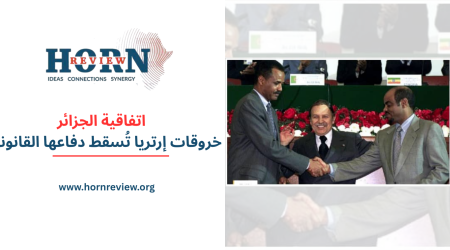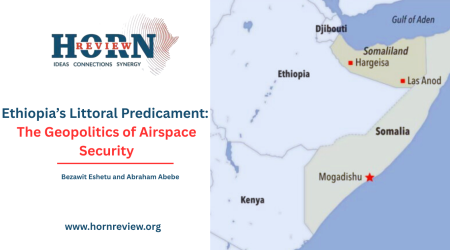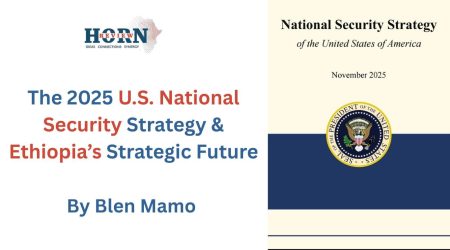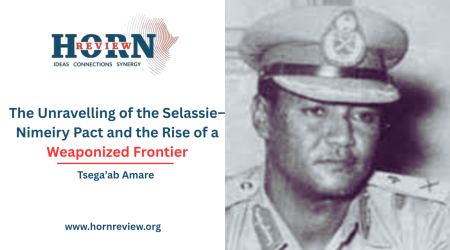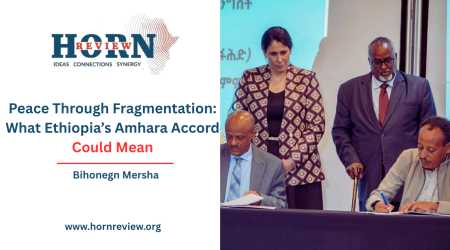
14
Jun
Ethiopia’s Border Security Challenge: Historical Legacies, Ethnic Realities, and the Imperative for an Independent Border Force
Ethiopia’s borders have long been shaped by complex historical forces and evolving geopolitical realities. Though the nation has a history of military resilience – most notably demonstrated in its decisive resistance to colonial encroachment at the Battle of Adwa in 1896 – it continues to grapple with the persistent challenges posed by its extensive and porous frontiers. The country’s borders, drawn largely through colonial-era agreements and influenced by shifting regional dynamics, remain a site of enduring vulnerability. These vulnerabilities are compounded by the ethno-cultural ties that span borders, internal political tensions, and the strategic interests of neighboring states. For Ethiopia, safeguarding its territorial integrity is not simply a matter of defense but a fundamental prerequisite for securing its sovereignty, economic stability, and diplomatic standing in an often volatile Horn of Africa.
To understand these challenges more deeply, it is essential to examine the historical origins rooted in colonial impositions and imperial diplomacy. Ethiopia largely escaped direct colonization, but its borders were nonetheless carved by agreements between colonial powers, often with scant regard for the ethnic and social fabric on the ground. The 1902 Anglo-Ethiopian Treaty, for example, established boundaries with British territories such as Sudan and Kenya, drawing lines that split communities and created ambiguous zones prone to dispute. Italy’s colonial ambitions further complicated this landscape, as reflected in the 1890 Treaty of Wuchale, whose disputed interpretations led to Italy’s colonization of Eritrea – territory Ethiopia considered its own – and sparked decades of conflict culminating in Eritrea’s independence in 1993. The subsequent Eritrean-Ethiopian War from 1998 to 2000 violently underscored the fragility of these borders and the ongoing volatility in the region.
These historical legacies continue to manifest in contemporary disputes, as seen vividly in regions like Al-Fashaga, a fertile strip along the Sudanese border whose ownership remains unresolved despite its immense economic significance. Periodic clashes in this area, such as those witnessed in 2020, highlight how porous and ill-defined borders translate into tangible losses of territory, resources, and political leverage. Meanwhile, Ethiopia’s extensive border with Kenya, marked by sprawling savannah and inhabited by pastoralist groups such as the Borana, poses distinct challenges. These communities, whose traditional migratory routes predate national boundaries, often straddle the international border, blurring lines of jurisdiction and enabling illicit trade and smuggling by illegal actors. Similar dynamics play out along the borders with Somalia’s Ogaden region and Gambella region, where armed groups and cross-border criminal networks exploit relatively weak state control and ethnic affiliations to evade authority.
Beyond territorial disputes, the ethno-cultural interconnectedness across Ethiopia’s borders presents additional complexities. On one hand, shared language, kinship, and customs among borderland communities foster deep social bonds that defy rigid national demarcations. On the other, they complicate security efforts by providing channels for insurgents, militants, and traffickers to navigate national boundaries with relative ease. For Ethiopia, where ethnic federalism structures domestic governance, internal conflicts such as the protracted tensions between the Tigray and Amhara regions ripple outward, destabilizing adjacent frontiers – particularly with Eritrea -where old hostilities remain simmering and border management is fragile.
Among neighboring states, Eritrea’s involvement is particularly acute and illustrative of these challenges. Its history of leveraging Ethiopia’s internal conflicts for strategic gain—whether through proxy support, cross-border incursions, or fomenting ethnic divisions—poses one of the greatest external security threats. Eritrea’s persistent militarization of the border and support for irregular armed actors exacerbate instability. Similarly, the situation along the Sudanese border adds another layer of complexity to Ethiopia’s border security. Sudanese factions and security forces have been implicated in arming and facilitating the movement of illicit arms and human trafficking networks across the disputed Al-Fashaga region and beyond. This trafficking undermines Ethiopia’s internal cohesion and fuels conflicts in peripheral areas, including in regions bordering South Sudan and the broader Horn.
Together, these external pressures converge to create Ethiopia’s most significant vulnerabilities. The potential for these destabilizing activities to spill into Ethiopia’s heartland, coupled with internal ethnic tensions and insurgencies, creates a strategic “soft underbelly” that external actors can exploit. This reality highlights the inextricable link between internal cohesion and external border security.
Compounding these threats is the sheer geographical scale and terrain of Ethiopia’s borders, which pose practical challenges for effective control. Stretching thousands of kilometers across mountains, deserts, and vast rural landscapes, the borders are difficult to monitor and secure comprehensively. This challenge is exacerbated by the ENDF’s dual responsibility: while charged with defending against external threats, it must also dedicate substantial resources to managing internal insurgencies and ethno-political unrest. This dual burden inevitably diverts critical manpower and equipment away from sustained border control efforts. Moreover, institutional weaknesses such as gaps in intelligence capabilities, occasional corruption, and inadequate collaboration with local populations further diminish the effectiveness of border enforcement.
As a result, Ethiopia faces a multifaceted and evolving threat landscape. Cross-border incursions, smuggling networks trafficking weapons and narcotics, human trafficking syndicates exploiting vulnerable populations, and militant groups leveraging ethnic and political fissures to destabilize border regions are all active challenges. The enduring animosity with Eritrea, clashes in Al-Fashaga, the ripple effects of the northern conflict, and insecurity along the Somali frontier collectively attest to the ongoing complexity of Ethiopia’s border security environment.
Although resolving internal conflicts and fostering national unity are critical, they alone are insufficient to address the full spectrum of border security challenges. Without the establishment of a dedicated, institutionalized border security force, Ethiopia remains exposed to persistent threats. Internal cohesion can diminish—but cannot fully eliminate—the strategic advantages that porous and poorly managed borders afford to hostile neighbors and transnational criminal networks.
Accordingly, internal stabilization efforts must be complemented by robust, professionalized border security institutions that can independently monitor, control, and respond to threats along Ethiopia’s extensive and complex frontiers. Only through this dual approach—internal stabilization combined with specialized border management—can Ethiopia hope to effectively insulate itself from the persistent incursions, trafficking, and provocations that have long undermined its sovereignty and security.
This necessity calls for a fundamental paradigm shift in how Ethiopia approaches border management. Reliance solely on the Ethiopian National Defense Force – primarily designed for conventional military operations -is insufficient for the nuanced and persistent demands of border security. The nature of border threats necessitates a specialized, autonomous border security force equipped with distinct mandates, skills, and operational methods. Such an institution would focus on constant vigilance, law enforcement, intelligence gathering, community engagement, and rapid response to localized incidents – functions that differ fundamentally from the broader strategic and combat roles of the military.
Such a specialized force would offer several critical advantages. First, it would foster specialization and professionalization in areas such as anti-smuggling operations, human trafficking interdiction, and customs enforcement – domains traditionally outside the Ethiopian National Defence Forces’ core competencies. Second, it would enable dedicated resource allocation and strategic focus, preventing the dilution of border security efforts by internal conflicts that continuously demand the ENDF’s attention. This separation, while maintaining institutional and sectoral integration, would ensure that border management receives sustained commitment, improving overall national resilience.
Moreover, Ethiopia’s unique social fabric demands a border force adept at nuanced community engagement. Such a force could cultivate trust and cooperation with local populations, whose intimate knowledge of the terrain and social dynamics is invaluable for early threat detection and border vigilance. Unlike conventional military units, often perceived as external actors, a border security agency embedded in the social realities of the periphery can build partnerships crucial to sustainable security.
In addition, establishing a distinct entity enhances legal and institutional clarity. It would foster the development of clear operational guidelines, accountability frameworks, and oversight mechanisms tailored to border policing rather than military enforcement. This shift would uphold the rule of law and human rights, aligning Ethiopia’s border management with international best practices seen in many states that maintain specialized border guards or customs agencies separate from their armed forces.
Another crucial benefit of an independent force is its adaptability. Ethiopia’s borders face a constantly shifting array of challenges – from ethnic tensions and militant movements to transnational crime – requiring a force agile enough to adjust tactics and coordinate rapidly with domestic agencies and neighboring countries. The military’s hierarchical and combat-focused structure is less suited for such fluid, multi-dimensional threats, underscoring the strategic necessity of a dedicated border security institution.
In summary, considering Ethiopia’s historical vulnerabilities and current realities, a comprehensive and institutionalized approach is imperative. Establishing an independent border security force is not merely an administrative choice but a strategic imperative. It would transform Ethiopia’s approach to its borders – from reactive and overstretched military deployments to proactive, specialized, and community-rooted security management.
Through institutionalizing this specialized border security force, Ethiopia stands to enhance its territorial integrity, deter external aggression, curb illicit cross-border activities, and improve its regional influence. More importantly, it can redirect its vast resources toward internal development, economic growth, and national unity – freeing itself from the perpetual strain of border insecurity and external manipulation. This transformation would not only safeguard Ethiopia’s borders but also reinforce its historic legacy as a resilient and sovereign actor in the Horn of Africa, adeptly navigating the challenges of both past and present.
By Blen Mamo, Executive Director, Horn Review

